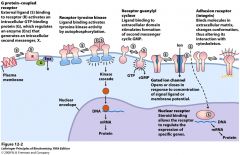![]()
![]()
![]()
Use LEFT and RIGHT arrow keys to navigate between flashcards;
Use UP and DOWN arrow keys to flip the card;
H to show hint;
A reads text to speech;
16 Cards in this Set
- Front
- Back
|
Discuss mechanisms that regulate transport of drugs across membranes.
|
-hydrophobicity
-hydrophilicity -lipid/water partition coefficinet -polar (ionization) |
|
|
Discuss the lipid/water partition coefficient and describe how it influences drug absorption.
|
partition coefficient determines [ ] gradient from membrane into cell cytosol (not extracelluular to intra)
|
|
|
Use the Henderson-Hasselbalch equation to determine the effect of local pH on drug transport across a membrane.
|
determines which ratio/fractn of w. acid or w. base will become charged, which amount can be absorbed
|
|
|
•Diagram and explain the following types of intercellular signaling systems:
endocrine, paracrine, and autocrine and give examples of agents and cells that utilize these types of pathways |
1. endocrine
-signals carried via blood to HIGH AFFINITY receptor far away -e.g. insulin, T4, ADH, epinephrine, cortisol 2. Paracrine -LOCAL effect (same tissue) -LOW AFFINITY receptors -e.g. histamine, prostaglandins, growth factors 3. Autocrine -sending/target cell same -embryonic develpmnt, inflammatory response -e.g. prostaglandin (PGE) in closing ductus arteriosus; histamine inhibition; T cell proliferation |
|
|
What systems utilize juxtacrine and synaptic signaling?
|
juxtacrine- immune system
synaptic signaling synaptic- neurotransmitter release into synapse -e.g. ACh, norepinephrine (NE), GABA, Glu, Asp, glycine |
|
|
List four different agents that signal via intracellular receptors
|
1. steroids (corticosteroids, mineralocorticoids, sex steroids, anabolic steroids)
2. thyroxine (T4) |
|
|
Explain the significance of each of the following in cell signaling:
•Specificity •Amplification •Desensitization •Integration |
1. specificity: fine control. 1 signal (agonist or antagonist) binds & activates or blocks specific receptor. Imp. for fine tuning.
2. amplification: fine control. Cascade. enzymes activate enzymes. Can have receptors responsive to low [ ] & amplify signal. 3. Desensitization: products made from receptor activation feedback to deactivate receptor. -e.g. tachyphylaxis (fast protection) in smooth muscles- stimuli produces less response over time -e.g. epidermal growth factor (EGF) 4. Integration: 2 signals have opposite effects on on [ ] of 2nd messenger (X) or membrane potential (Vm) |
|
|
Discuss how pleiotropic pathways can influence cell function in a
coordinated manner |
multiple pathways (e.g. ion txport, gene expression, cell movement, metabolism) affected by same stimulus
-e.g. release of insulin--> uptake of glucose into cell, opening of gateways; storage of glucose |
|
|
6 classes of signaling receptors
|

|
|
|
Give examples of 2nd messengers and describe how they work
|
-e.g. cAMP; ionized Ca2+; cGMP; lipids (IP3, DAG)
|
|
|
Explain how the B-adrenergic receptor increases cyclic AMP formation
|
B-adrenergic receptor is GPCR
|
|
|
Discuss the general function of antibodies in the immune response.
|
1. Neutralize toxins (bind to & clear s/tng)
2. Immobilize microorganisms 3. Neutralize viral activity 4. Agglutination 5. Binding soluble AG (ppt) 5. Activating complement |
|
|
Identify the basic functions of each of the 5 classes of
immunoglobulin. Know which class predominates in a primary vs secondary immune response. |
1.IgM
-pentamer, disulfide bonds hold together, fixes complement, agglutinatn, dsn't cross placenta, AG recptor on surface of B cells 2. IgG -75% circulating Ig, main AB in 2' response (i.e. for immunizatn), can cross placenta 3. IgA -dsn't fix complement, present in milk, saliva, GI secretns, xists as dimer 4. IgE -allergies 5. IgD -AG receptor in immune resp? |
|
|
Discuss how diversity in antibody repertoire is achieved via
combinatorial gene rearrangement. |
recombination of V, D, J segments thru DNA deletn; heavy chain has more V domains
|
|
|
Differentiate between polyclonal and monoclonal antibodies.
|
polyclonal
-more than one B cell can respond to immunogen monoclonal -each B cell makes only 1 AB |
|
|
Discuss the role of “humanized” antibodies in Describe the structure
of the T cell receptor. |
to decr immune resp. to AB
|

